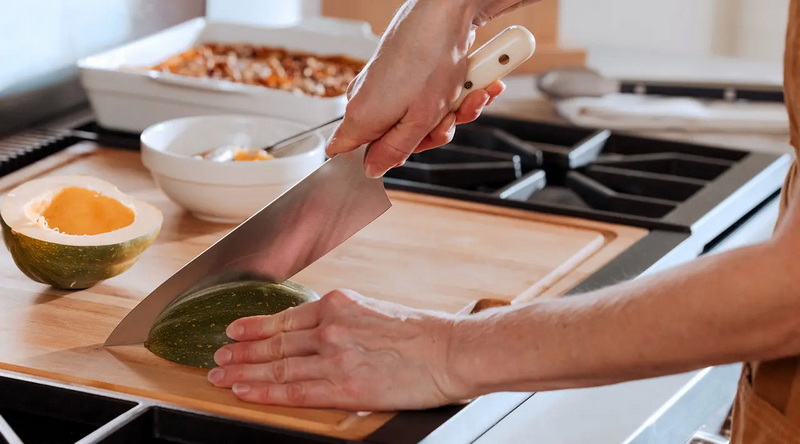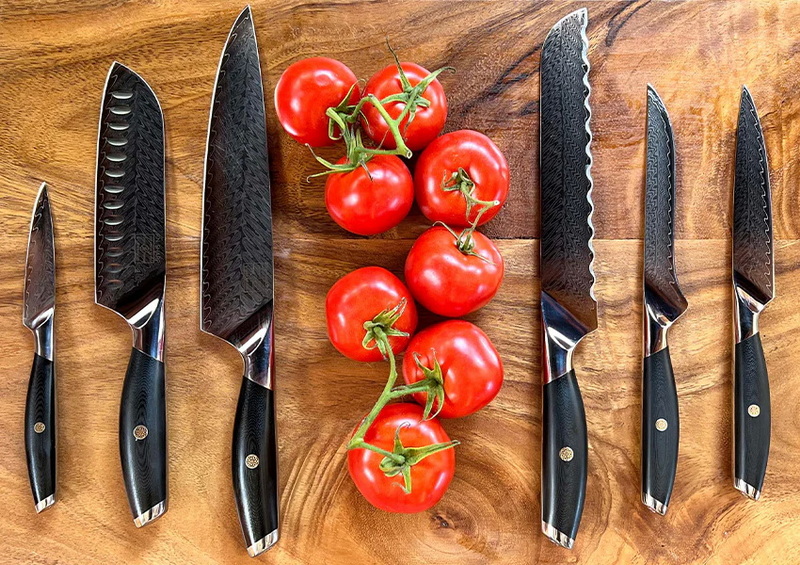

Views: 222 Author: Ella Publish Time: 2025-05-24 Origin: Site








Content Menu
● How to Hold a Vegetable Knife
● Basic Techniques for Using a Vegetable Knife
>> Push-Forward and Pull-Back Slicing
>> Using the Knuckle as a Guide
● Step-by-Step Guide to Cutting Vegetables with a Vegetable Knife
>> Step 1: Prepare Your Vegetables
>> Step 2: Secure Your Cutting Board
>> Step 3: Position Your Hands
>> Step 5: Move and Transfer Ingredients
● Popular Vegetable Cutting Techniques Using a Vegetable Knife
>> Julienne Cut
● Choosing the Right Vegetable Knife for Your Needs
● Safety Tips When Using a Vegetable Knife
● How to Maintain Your Vegetable Knife
● Advanced Techniques and Tips for Using a Vegetable Knife
>> Katsuramuki (Rotary Peeling)
● FAQ
>> 1. What is the difference between a vegetable knife and a chef's knife?
>> 2. Can I use a vegetable knife for fruits?
>> 3. How do I julienne vegetables using a vegetable knife?
>> 4. How do I keep my fingers safe when using a vegetable knife?
>> 5. How do I clean and maintain a vegetable knife?
Using a vegetable knife effectively is an essential skill for anyone passionate about cooking with fresh produce. A vegetable knife, often known as a Nakiri in Japanese culinary tradition, is specially designed to make chopping, slicing, dicing, and peeling vegetables easier, safer, and more precise. This comprehensive guide will explore how to use a vegetable knife, the techniques involved, safety tips, maintenance, and the various cuts you can achieve to elevate your culinary creations.

A vegetable knife is a kitchen knife designed specifically for cutting vegetables and fruits. It typically features a flat, rectangular blade with a squared-off or slightly rounded tip, allowing for clean, straight cuts without the rocking motion common with Western chef's knives. The blade is often thin and sharp, facilitating precision and ease when slicing through produce. The Nakiri knife is a popular Japanese-style vegetable knife characterized by its straight edge and double bevel, making it ideal for up-and-down chopping motions.
Unlike the Usuba knife, which is single-beveled and used for delicate, decorative vegetable cuts, the Nakiri is double-beveled, making it more user-friendly and versatile for everyday kitchen use. Its broad blade also allows for easy scooping and transferring of chopped vegetables.
Proper grip is crucial for control and safety when using a vegetable knife.
- Pinch Grip: Hold the knife by pinching the blade between your thumb and index finger near the handle, while wrapping the remaining fingers around the handle. This grip offers maximum control over the blade and precision in cutting.
- Claw Grip for the Other Hand: Curl the fingertips of your non-dominant hand inward, forming a claw shape to hold the vegetable. This protects your fingers and uses your knuckles as a guide for the knife.
Vegetable knives like the Nakiri are designed for a straight up-and-down chopping motion rather than the rocking motion used with chef's knives. This method allows the blade to cut cleanly through vegetables without the tip digging into the cutting board, making chopping faster and more efficient.
For slicing tasks, hold the blade edge against the vegetable and use a smooth push-forward and pull-back motion. This technique is especially useful for cutting vegetables like potatoes, apples, and carrots quickly and evenly.
Your knuckles on the holding hand should gently touch the side of the blade to guide the knife and maintain even cuts while protecting your fingertips from accidental cuts.
- Wash and peel your vegetables if necessary.
- Trim off ends to create flat surfaces for stability.
- For round vegetables, slice a thin piece off one side to prevent rolling on the cutting board.
Place a damp cloth or non-slip mat under your board to keep it steady and prevent slipping during cutting.
- Use the pinch grip on the knife.
- Form a claw with your other hand to hold the vegetable securely.
- Use the up-and-down chopping motion for most vegetables.
- For slicing, use the push-forward and pull-back technique.
- Keep the blade flat to the cutting board for even cuts.
The wide blade of a vegetable knife makes it easy to scoop and transfer chopped vegetables from the board to your pot or pan.
This cut produces thin, matchstick-like strips ideal for salads, stir-fries, and garnishes.
- Slice the vegetable into thin planks (3-4mm thick).
- Stack the slices and cut into uniform strips about 3mm wide.
Dicing involves cutting vegetables into small cubes. Brunoise is a finer dice, often used for garnishes.
- Start by slicing vegetables into planks.
- Cut planks into strips.
- Cut strips into cubes.
- Round slice (Wa-giri): Cut cylindrical vegetables into circular slices.
- Half-moon slice (Hangetsu-giri): Cut vegetables lengthwise in half, then slice to create half-moon shapes.
Cut vegetables into irregular but similarly sized pieces to increase surface area for faster cooking and better flavor absorption.

While the Nakiri is the most common vegetable knife, there are other specialized knives for vegetable preparation:
- Nakiri Knife: Double-beveled, rectangular blade, ideal for chopping, slicing, and dicing vegetables. It excels at handling hard vegetables like pumpkins and squash.
- Usuba Knife: Single-beveled, used by professionals for intricate decorative cuts and ultra-thin slicing. Requires more skill and maintenance.
- Turning Knife: Smaller with a curved blade, perfect for peeling and shaping round vegetables and fruits.
- Peeling Knife: Small knife with a sharp blade designed for peeling vegetables and fruits.
- Tomato Knife: Small serrated blade designed to cut through the tough skin of tomatoes without crushing them.
Choosing the right knife depends on the types of vegetables you commonly prepare and your skill level. For most home cooks, the Nakiri's double-bevel design offers an excellent balance of precision, ease of use, and versatility.
- Always use a sharp knife; dull knives are more dangerous as they slip easily.
- Keep your fingers curled inward on the holding hand to avoid cuts.
- Never use the same knife for vegetables after cutting raw meat to prevent cross-contamination.
- Carry knives with blades pointing down and close to your side.
- Do not leave knives loose on countertops where they can fall.
- Use a stable cutting board and secure it to prevent slipping.
- Never put knives in a sink full of water where they can be hidden and cause injury.
- Regularly sharpen the blade using a whetstone or knife sharpener to keep it razor-sharp.
- Hand wash and dry immediately after use to prevent rust and damage.
- Store in a knife block or magnetic strip to protect the edge.
- Avoid cutting on hard surfaces like glass or stone, which can dull the blade.
- Occasionally hone the blade with a honing rod to maintain edge alignment between sharpenings.
Though typically done with a single-beveled Usuba knife, the katsuramuki technique involves peeling vegetables like daikon radish into thin, continuous sheets by rotating the vegetable against the blade. While the Nakiri is not designed for this, mastering the basics of vegetable cutting with a Nakiri can prepare you for exploring such advanced techniques with other knives.
Keep your vegetables organized and prepped in batches. Use the broad blade of the Nakiri to scoop up chopped vegetables and transfer them to your cooking vessel, minimizing trips back and forth to the cutting board.
For harder vegetables like squash or pumpkin, use the full length of the blade with controlled pressure. The flat, broad blade of the Nakiri distributes force evenly, making it easier to cut through tough skins without excessive effort.
Mastering the use of a vegetable knife transforms your kitchen experience by making vegetable preparation faster, safer, and more precise. Whether you are julienning carrots for a salad, dicing onions for a stew, or slicing cucumbers for a garnish, the vegetable knife's design and cutting techniques enable professional-quality results at home. Coupled with proper safety practices and maintenance, this tool is indispensable for anyone serious about cooking with fresh vegetables. Selecting the right vegetable knife, understanding its unique features, and practicing proper techniques will elevate your cooking efficiency and enjoyment.

A vegetable knife usually has a straight, rectangular blade with a blunt tip designed specifically for chopping vegetables with an up-and-down motion, while a chef's knife has a curved blade for rocking cuts and is more versatile for various kitchen tasks.
Yes, vegetable knives are excellent for slicing and peeling fruits like apples, pears, and melons due to their sharp, precise blades.
Slice the vegetable into thin planks, stack them, then cut into thin, uniform strips about 3mm wide using a straight slicing motion.
Use the claw grip by curling your fingertips inward and use your knuckles as a guide for the blade to prevent accidental cuts.
Hand wash immediately after use, dry thoroughly, sharpen regularly, and store safely in a knife block or magnetic strip to keep the blade sharp and rust-free.